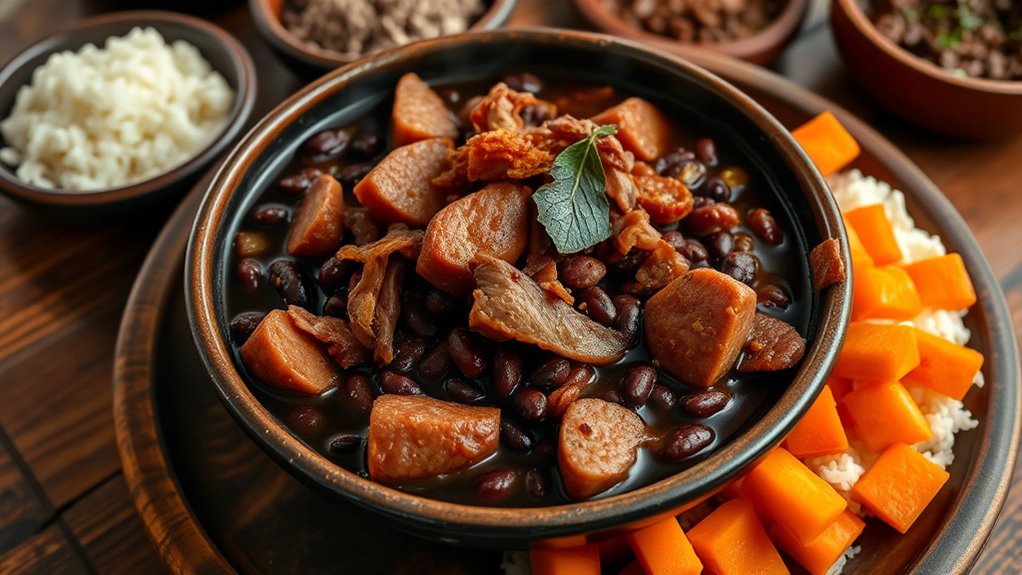Brazilian feijoada is a hearty, smoky stew made with black beans, pork, sausages, and flavorful spices. It’s a dish that reflects Brazil’s rich history, blending Indigenous, African, and Portuguese influences. Typically served hot with rice, greens, and farofa, it’s a comforting meal that celebrates resilience and community. This dish’s unique flavors and cultural significance make it a beloved Brazilian classic—keep going to uncover more about its fascinating origins and ingredients.
Key Takeaways
- Feijoada is a traditional Brazilian bean stew made with black beans and salted smoked meats.
- It symbolizes Brazil’s diverse cultural roots, blending Indigenous, African, and Portuguese influences.
- The dish is slow-cooked to develop rich, smoky flavors and hearty textures.
- Common accompaniments include white rice, sautéed greens, and farofa, creating a balanced meal.
- Feijoada is a cultural emblem, celebrating resilience, community, and Brazil’s culinary heritage.

Brazilian feijoada is a hearty and flavorful stew that captures the essence of Brazil’s culinary tradition. Its origins trace back to a complex history background that blends Indigenous, African, and Portuguese influences. Originally, enslaved Africans brought their cooking styles and ingredients, which merged with local produce and Portuguese culinary traditions to create this iconic dish. Over the centuries, feijoada evolved from a humble peasant meal into a celebrated national dish, symbolizing unity and shared heritage across Brazil. Its rich history reflects a story of resilience and adaptation, making it more than just a meal—it’s a cultural emblem.
Brazilian feijoada is a rich, cultural stew blending Indigenous, African, and Portuguese influences.
When it comes to traditional ingredients, feijoada relies on a specific set of components that give it its distinctive flavor. At the heart of the dish are black beans, which are soaked and cooked to form a thick, savory base. You’ll typically add a variety of salted and smoked meats, such as pork shoulder, sausages (like chorizo and linguiça), and sometimes smoked ribs. These meats lend a deep, smoky flavor that permeates the beans and creates a hearty, comforting stew. You’ll also find ingredients like garlic, onions, bay leaves, and black pepper, which enhance the dish’s flavor profile. To add a touch of brightness and freshness, cooks often include chopped parsley or cilantro. Traditional feijoada is usually served with sides such as white rice, collard greens sautéed with garlic, and farofa—a toasted cassava flour mixture that adds texture. Additionally, many cooks incorporate slow cooking techniques to deepen the flavors and tenderize the meats, ensuring a rich and satisfying dish.
The preparation of feijoada is straightforward but requires some patience to develop its full flavor. You start by soaking the beans overnight, which helps reduce cooking time and improves digestibility. The meats are typically simmered separately to tenderize and develop their smoky aroma before being added to the beans. Once everything is combined and cooked through, the stew develops a thick, hearty consistency. The dish is best enjoyed hot, accompanied by rice and greens, offering a perfect balance of savory, smoky, and fresh flavors.
Understanding the history background and traditional ingredients of feijoada gives you a deeper appreciation for what makes this dish so special. It’s more than just a meal; it’s a celebration of Brazil’s diverse cultural roots. Each ingredient tells a story of migration, adaptation, and community, making feijoada a true reflection of Brazilian history and culinary ingenuity. So, when you sit down to enjoy this classic stew, remember that you’re tasting centuries of tradition, crafted with simple ingredients that come together to create something truly memorable.
Frequently Asked Questions
What Are the Origins of Brazilian Feijoada?
You might find it fascinating that Brazilian feijoada has rich history origins rooted in Portuguese colonial times. It combines ingredients from both African and Portuguese cultures, reflecting Brazil’s diverse heritage. Today, feijoada holds deep cultural significance as a communal dish enjoyed during gatherings. Its history shows how resourcefulness and cultural blending created this hearty, iconic stew, symbolizing unity and tradition in Brazilian cuisine.
Can Feijoada Be Made Vegetarian?
Yes, you can make feijoada vegetarian. Simply replace meat with flavorful meat alternatives like tofu or tempeh, and add hearty vegetarian toppings such as sautéed vegetables, avocado, or plant-based sausages. Use vegetable broth instead of traditional meat-based broths to keep it rich and satisfying. This way, you enjoy a delicious, hearty feijoada that’s entirely vegetarian without sacrificing taste or texture.
How Long Does Feijoada Typically Take to Cook?
Feijoada typically takes about 2 to 3 hours to cook, depending on your preparation process. You’ll start by soaking the beans overnight, then simmering the ingredients until the flavors meld and the beans become tender. During cooking time, you’ll need to occasionally check and stir your stew. Patience is key, as this hearty dish develops its rich taste through slow, deliberate cooking.
What Are Traditional Side Dishes Served With Feijoada?
You’ll find traditional side dishes like white rice, collard greens, orange slices, and farofa served with feijoada. Cultural variations influence these accompaniments, so in some regions, you might see different vegetables or grains. Modern adaptations often include adding spicy salsa or different types of bread. These sides complement the hearty stew, balancing flavors and textures, making your feijoada experience authentic and customizable to your taste preferences.
Is Feijoada Suitable for Gluten-Free Diets?
Yes, feijoada can be suitable for gluten-free diets if you use gluten-free ingredients and watch for cross-contamination. Stick to naturally gluten-free items like beans, meats, and vegetables. Be cautious with processed sausages or seasonings that might contain gluten or have been prepared with cross-contamination concerns. Always check labels and ask about ingredients when dining out to guarantee your meal remains safe and gluten-free.
Conclusion
Now that you know how to prepare and enjoy Brazilian feijoada, isn’t it tempting to gather friends and share this rich, comforting dish? Its hearty beans, savory meats, and bold flavors create more than just a meal — they offer a taste of Brazil’s vibrant culture. So, why not bring a little of that warmth and tradition to your table? After all, isn’t good food best enjoyed with good company?









